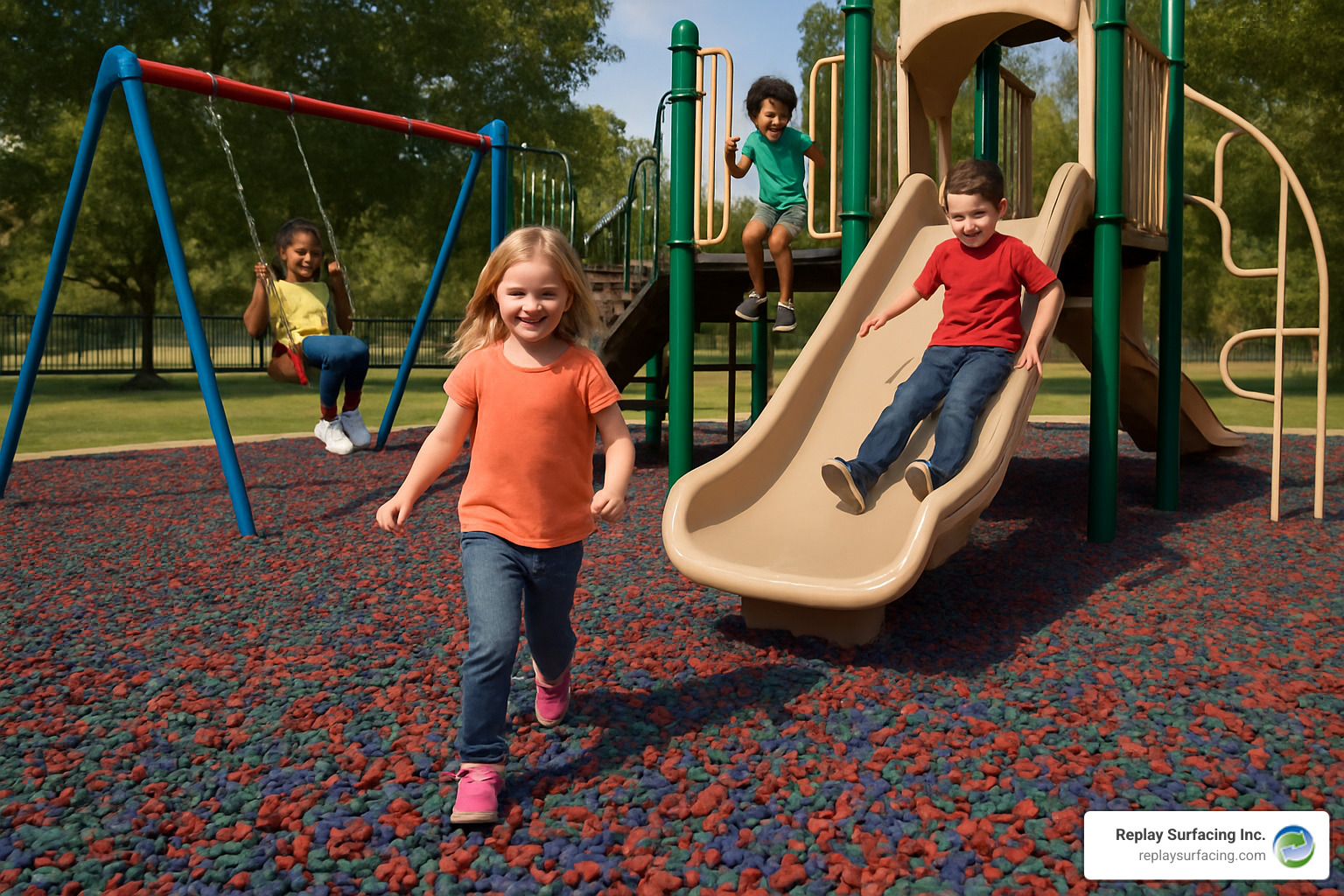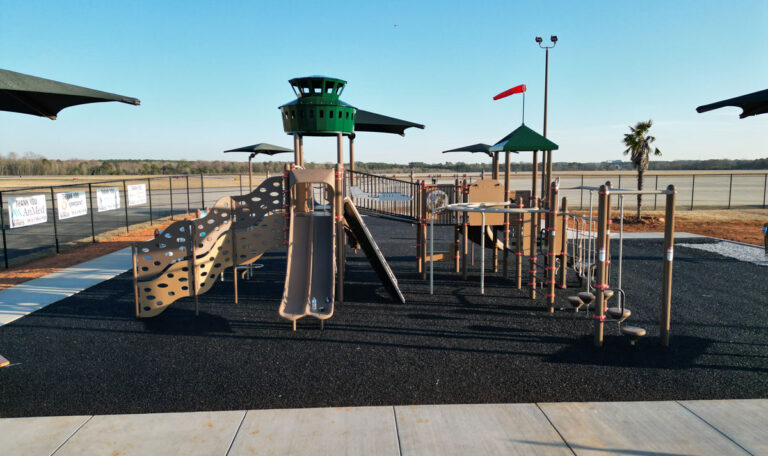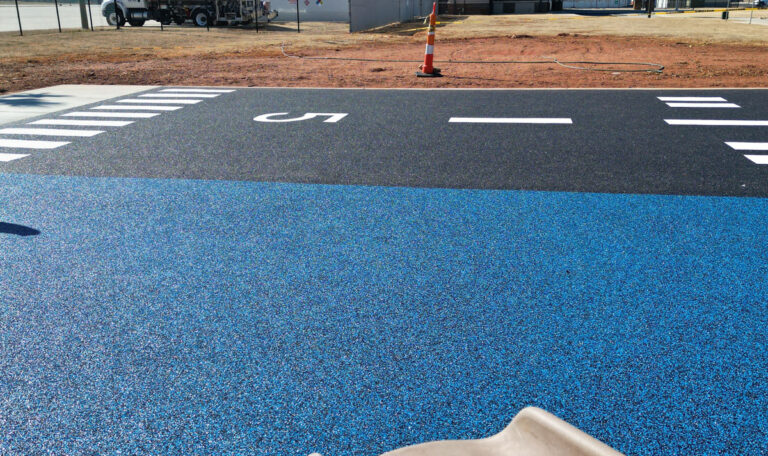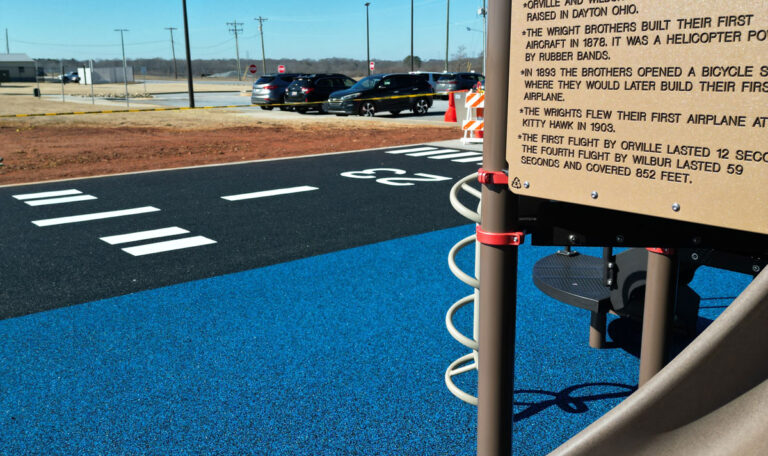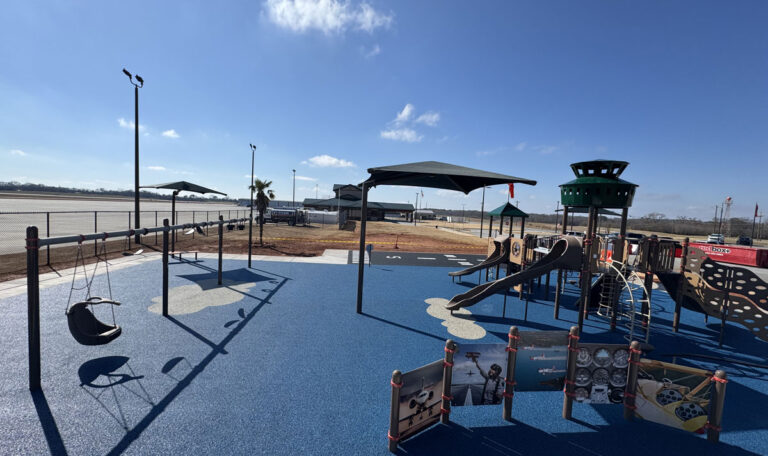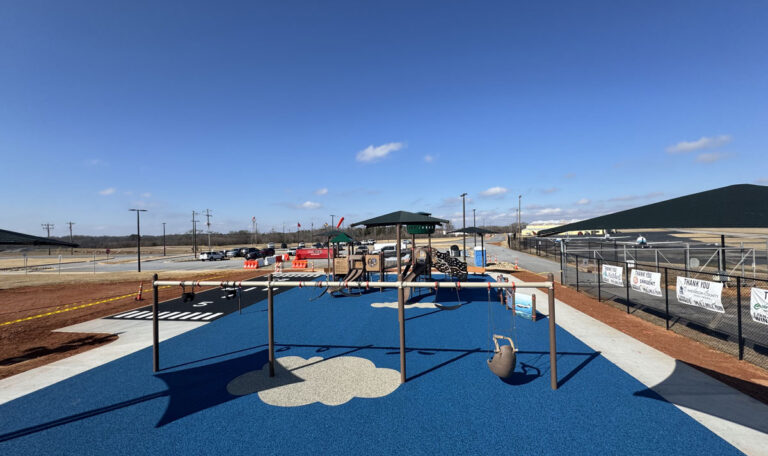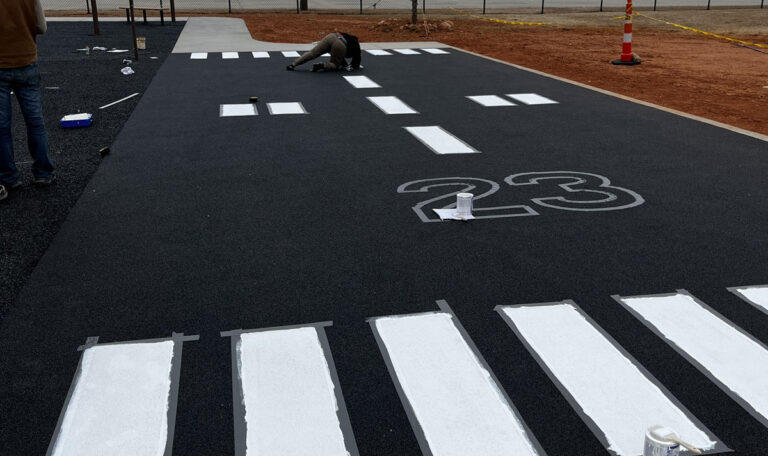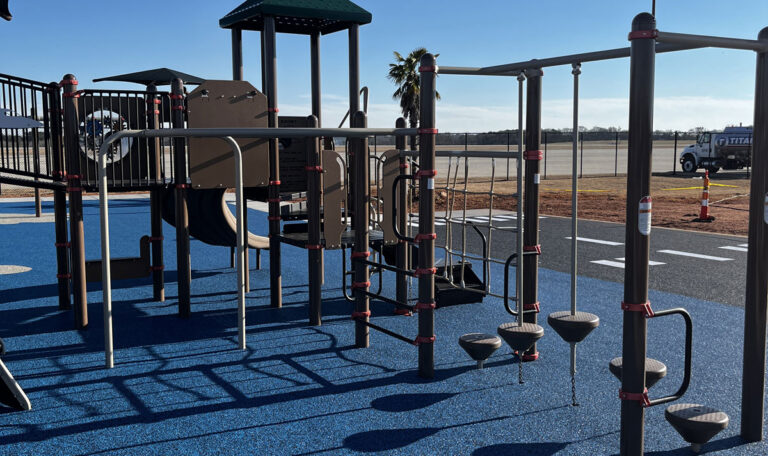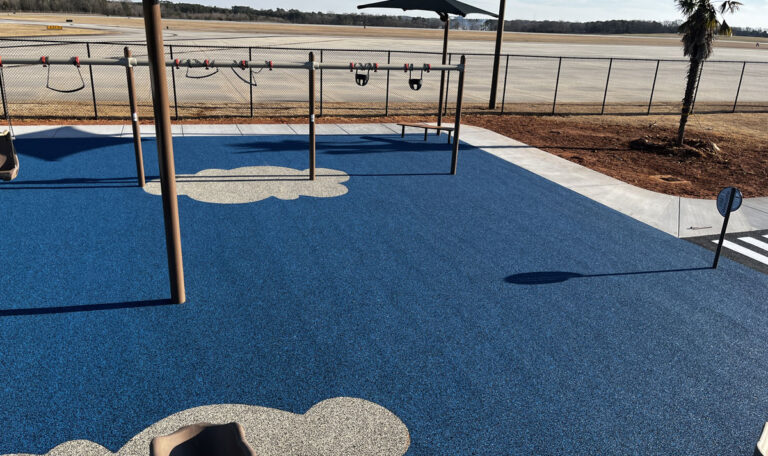Finding the Best Rubber Mulch Per Ton Deals for Your Project
Rubber mulch per ton pricing ranges from $529 to $789 depending on color and supplier, with one ton covering approximately 260-300 square feet at a 3-inch depth. Here’s what you need to know about bulk rubber mulch costs:
Quick Pricing Guide:
- Basic Black: $529-$599 per ton
- Colored Options: $635-$789 per ton
- Coverage: 260-300 sq ft at 3″ depth per ton
- Weight: 2,000 lbs = 2.65 cubic yards
- Delivery Time: 1.5-2 weeks typically
Whether you’re managing a school playground, sports facility, or residential play area, buying rubber mulch by the ton offers significant savings over bagged options. Made from 100% recycled tires, this sustainable surfacing material provides superior fall protection – 2.5 times better than traditional wood mulch, sand, or gravel.
The math is simple: one ton of rubber mulch replaces what would cost hundreds more in annual wood mulch replacements. Plus, it meets ASTM safety standards, offers ADA compliance, and comes with up to 12-year color warranties.
I’m Landon Olson, a mechanical engineer who has spent years in the sustainability and safety surfacing industries, helping facilities transition to eco-friendly solutions like rubber mulch per ton purchases.
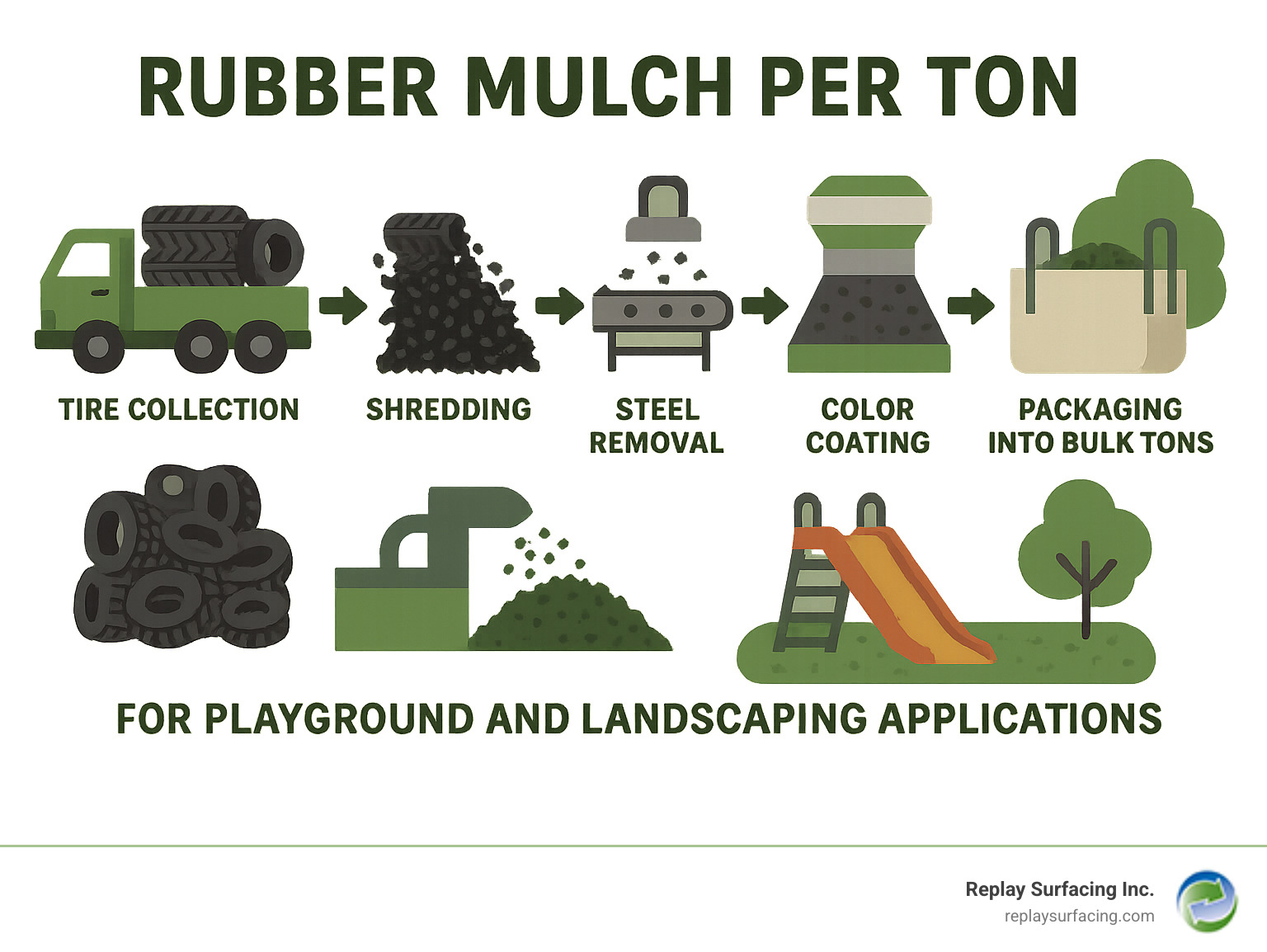
Rubber mulch per ton terms you need:
What Is Rubber Mulch & How It’s Made
Every piece of rubber mulch per ton we produce at Replay Surfacing starts with old, worn-out tires. Those massive truck tires and discarded car tires all have the potential to become safe, colorful playground surfaces through our Recycled Rubber Mulch process.
The journey from tire to mulch begins by collecting end-of-life tires from tire shops, trucking companies, and recycling centers. These aren’t just any old tires – we’re talking about rubber that was engineered to withstand thousands of miles of road abuse, which makes it perfect for playground surfacing.
The first step involves removing all non-rubber components. Rims, valve stems, and metal parts get stripped away before industrial shredding. These powerful machines tear whole tires into nugget-sized pieces, typically between 0.5 and 2 inches.
Steel removal is where precision matters most. Even after initial metal removal, tiny steel belting wires can hide inside the rubber. We use high-powered magnets and sensitive metal detectors to achieve 99.9% steel-free mulch. This step is crucial for safety – no parent should worry about their child finding metal fragments in playground mulch.
Here’s where the sustainability loop gets impressive: approximately 50,000 tires are diverted from landfills to produce just one ton of rubber mulch. When you consider that a single tire can sit in a landfill for over 600 years without decomposing, the environmental impact becomes clear.
Color-sealing creates the final magic. Basic black rubber mulch keeps the tire’s natural color, but our colored options receive specialized treatment. This isn’t surface paint that chips off after one season. The color-sealing process penetrates deep into the rubber surface, creating bonds that resist fading for up to 12 years.
Before any rubber mulch per ton leaves our facility, it goes through rigorous quality testing including metal content verification, particle size consistency, color fastness testing, non-toxicity confirmation, and impact absorption measurement.
Rubber Mulch Per Ton: Coverage, Weight & Price Basics
Let’s break down the numbers that matter for your rubber mulch per ton purchase. One ton of rubber mulch weighs exactly 2,000 pounds and equals about 2.65 cubic yards of material. But what really matters is how much ground it covers.
At the standard playground depth of 3 inches, one ton spreads across 260 to 300 square feet. The exact coverage depends on whether you choose shredded or nugget-style mulch – shredded tends to settle and compact a bit more during installation.
For landscaping projects where you only need 2-inch depth, that same ton stretches to around 450 square feet. This makes rubber mulch surprisingly budget-friendly for large flower beds and decorative areas.
Current rubber mulch per ton pricing sits in the $529 to $789 range, with color being the biggest price driver. Basic black runs $529-$599 per ton, while earth tones like brown cost $635-$665. Bright playground colors push prices up to $665-$789 per ton.
Don’t forget about freight costs. Rubber mulch ships as heavy freight, typically adding $100-$300 per ton depending on distance from regional warehouses. Volume discounts start around 3-4 tons, shaving $20-$40 off each ton.
Here’s a handy comparison table showing how depth affects your coverage:
| Depth | Coverage per Ton | Best For |
|---|---|---|
| 2 inches | 390-450 sq ft | Landscaping, light foot traffic |
| 3 inches | 260-300 sq ft | Standard playgrounds, fall heights up to 10 feet |
| 6 inches | 130-150 sq ft | Commercial playgrounds, maximum safety |
You can calculate your exact needs using online tools, but the basic formula is simple: measure your area in square feet, divide by the coverage number for your chosen depth, then add 10% extra for settling.
How Many Square Feet Does One Ton Cover?
The magic number for most playground projects is 3-inch depth, where one ton covers 260-300 square feet. This depth provides fall protection for equipment up to 10-12 feet high and meets ASTM safety requirements for most residential and school playgrounds.
For landscaping applications, 2-inch depth is usually plenty. Here, one ton stretches to cover 390-450 square feet, making it perfect for garden beds and decorative areas where you mainly want weed suppression and visual appeal.
Commercial playgrounds with taller equipment often require 6-inch depth for maximum safety. At this depth, one ton only covers 130-150 square feet, but you’re getting ultimate fall protection for equipment over 12 feet high.
Typical Cost Breakdown per Ton
Understanding what drives rubber mulch per ton pricing helps you make smarter buying decisions. The base material cost runs $400-$550 per ton, covering tire collection, shredding, steel removal, and quality testing.
Color premiums add $50-$200 to your base cost. Earth tones are more affordable because they’re closer to natural rubber color. Bright playground colors require more intensive processing.
Shipping zones dramatically affect your total cost. Freight runs $100-$300 per ton depending on distance from regional warehouses. Volume discounts make bulk buying attractive – order 3-4 tons and save $20-$30 per ton. Buy 5+ tons and discounts jump to $30-$50 per ton.
Seasonal timing affects costs too. Spring ordering carries premium pricing due to high demand. Fall and winter orders sometimes qualify for off-season discounts of 5-10%.
Smart buyers also consider our Used Rubber Mulch options for additional savings.
Benefits & Drawbacks vs Wood Mulch
When parents ask me about playground safety, the numbers tell a clear story: rubber mulch per ton provides 2.5 times better fall protection than wood mulch, sand, or pea gravel. This isn’t just marketing talk – it’s backed by rigorous ASTM F1292 impact testing.
Wood mulch starts out decent, but it compacts and loses its cushioning power within just a few months of heavy use. Meanwhile, rubber mulch maintains that same protective bounce year after year, even in the busiest playground zones.
The maintenance story is where rubber mulch really shines. Wood mulch needs complete replacement every single year, costs $30-$60 per cubic yard, and you’re constantly raking and refreshing it as it breaks down. With rubber mulch per ton purchases, you make the investment once and you’re done for over a decade.
Rubber mulch does get hotter than wood alternatives on scorching summer days – sometimes uncomfortably hot for bare feet. This matters if you’ve got kids who love going shoeless.
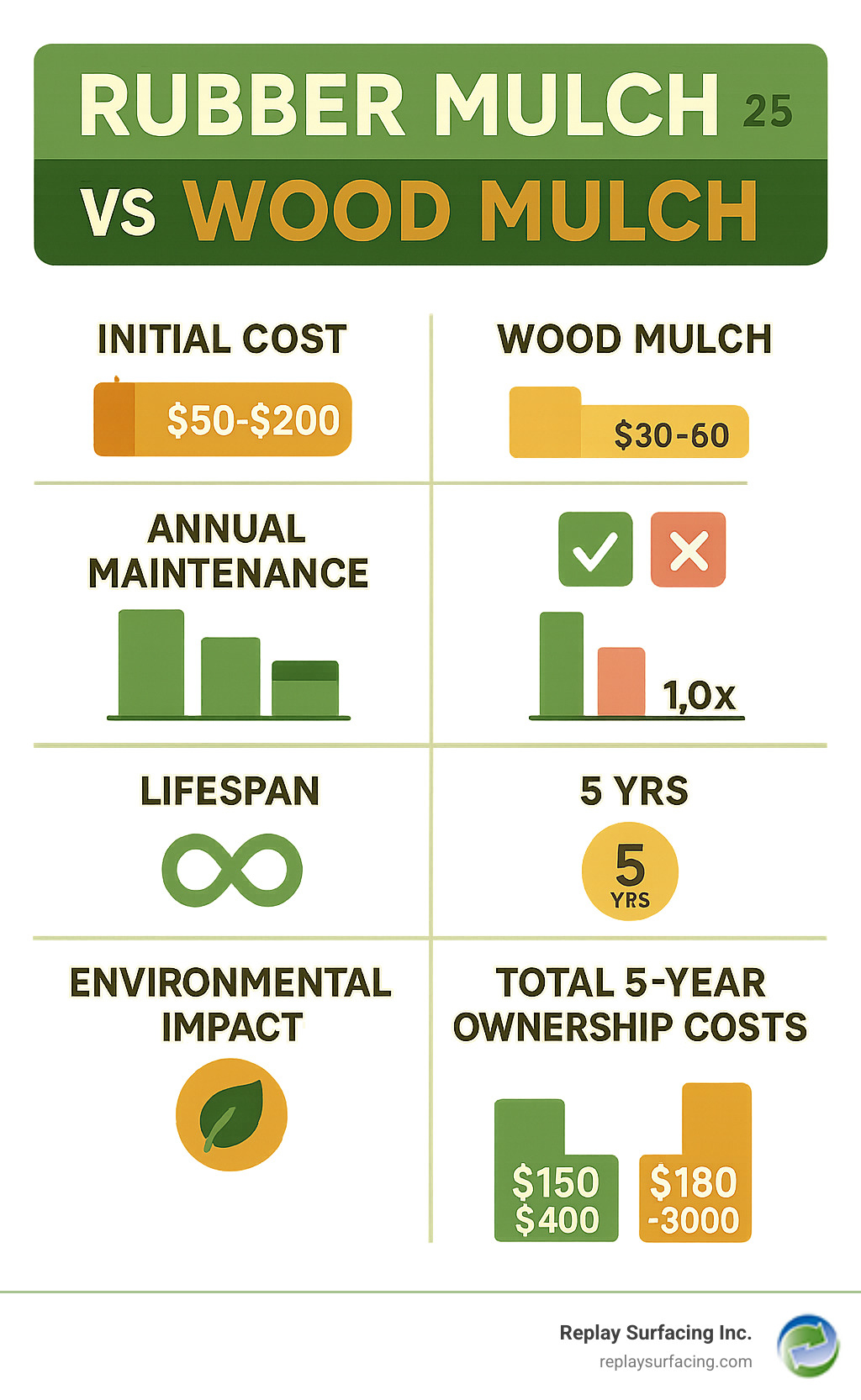
8 Key Advantages
The superior fall protection is where rubber mulch really proves its worth. At 6-inch depth, it protects kids from falls up to 16 feet high. Wood mulch maxes out around 10-11 feet and gets weaker as it settles.
ADA accessibility is another game-changer. Rubber surfaces meet ASTM F1951-99 wheelchair standards because they create a firm, stable surface. Kids using mobility devices can actually steer and play, unlike with loose wood chips.
The zero decomposition factor eliminates many headaches. No more musty smells, no rotting, no insects making themselves at home. Wood mulch turns into a bug hotel pretty quickly.
Quick-dry performance means your playground is ready hours after a rainstorm, not days. Fade-resistant colors keep looking fresh year after year with our color-lock process ensuring vibrant hues last 12+ years.
Natural weed suppression happens because that dense rubber layer blocks sunlight completely. No chemicals needed, no constant weeding.
The extended lifespan of 10-15 years with minimal maintenance speaks for itself. Long-term cost savings of 65% over five years make the higher upfront investment worthwhile.
4 Considerations Before You Buy
Surface temperature concerns are real, especially with darker colors. Black rubber mulch can hit 150°F+ on sunny summer days. If you’ve got lots of barefoot traffic, lighter colors or shade structures become important.
Static electricity can build up on dry rubber mulch, particularly when humidity is low. It’s rarely a serious problem, but it might surprise sensitive kids.
Border containment requirements matter because rubber mulch can migrate without proper edging. Budget for landscape borders or containment systems.
Initial budget impact is probably the biggest hurdle. Rubber mulch per ton costs 3-4 times more upfront than wood alternatives. However, when you calculate total ownership costs over time, rubber comes out way ahead.
For detailed guidance, check out our Advantages of Playground Rubber Mulch: Safety, Maintenance, and Durability resource.
Buying, Delivery & Installation Tips
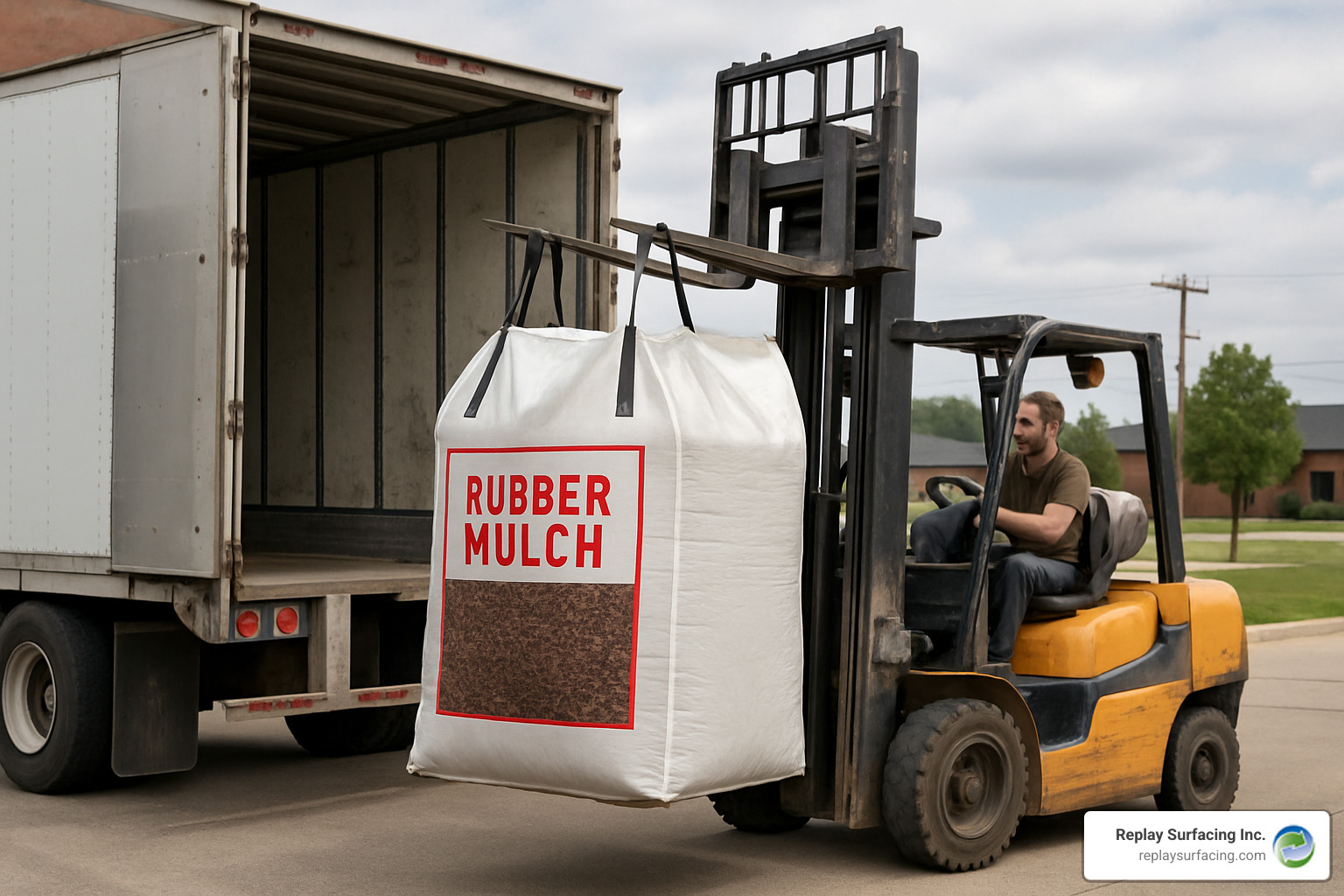
Ordering rubber mulch per ton is different from grabbing bags at your local store. The logistics matter more when dealing with thousands of pounds of material.
Super sacks are your most budget-friendly option. These massive 2,000-pound bags look intimidating, but one bag equals exactly one ton. The catch? You’ll need a forklift to move them. If you don’t have one, lift-gate delivery gets the job done for an extra $75-$150.
Many customers prefer palletized 40-pound bags for convenience. Picture 50 manageable bags stacked on a pallet, totaling one ton. You’ll pay $50-$100 more per ton, but your crew can handle installation without heavy machinery.
Lead times typically run 1-2 weeks from order placement. Spring gets busy (everyone wants playgrounds ready for warm weather), so expect 3-4 weeks during peak season.
Local pickup can slash freight costs if you’re near our locations in Charlotte NC, Columbia SC, Raleigh NC, Sanford NC, Tucson AZ, Connecticut, Indiana, Nashville TN, Beaverton OR, or Lake Charles Louisiana.
Most deliveries happen curbside unless you pay for white-glove service. Those big freight trucks need room to maneuver – 53-foot trailers that require straight-line access.
Calculating How Much You Need
Getting quantities right saves headaches and money. Start with precise measurements of your installation area. Break weird shapes into simple rectangles for easier calculation.
Target depth makes a huge difference. Landscaping beds need 1.5-2 inches. Residential playgrounds require 3 inches for basic safety. Commercial installations often go 6 inches deep.
Here’s the math: A 40-foot by 60-foot main play area equals 2,400 square feet. Add a 20-foot by 30-foot swing zone (600 square feet), and you’re at 3,000 total square feet. At 3-inch depth, divide by 280 square feet per ton coverage. That gives you 10.7 tons.
Always add 10% extra for settling and touch-ups. Round that 10.7 tons up to 12 tons. It’s cheaper to order more upfront than pay separate freight charges later.
For complex projects, our Calculate Shredded rubber mulch | Cubic Yard (or Feet) to Tons calculator handles the heavy lifting. Our Loose Rubber Mulch page shows real project examples.
Packaging & Shipping Options
Super sacks win on economics every time. One massive bag per ton keeps things simple and costs down. The trade-off is handling – you need a forklift or skid steer.
Palletized bags offer flexibility for smaller crews. Each 40-50 pound bag is manageable by one person, and 50 bags per pallet equals exactly one ton.
Freight classification affects shipping costs. Our regional warehouse network keeps delivery times reasonable – seven strategically located warehouses mean your order typically arrives within 1.5-2 weeks.
Delivery options range from basic curbside (included) to full inside delivery (extra cost). Lift-gate service adds $75-$150 but eliminates the forklift requirement.
Once materials arrive, our detailed Installing Rubber Mulch guide walks you through the entire installation process.
Safety, Lifespan & Sustainability
When investing in rubber mulch per ton, safety certifications aren’t just paperwork – they’re your guarantee that children will be protected. Every quality rubber mulch product should carry IPEMA (International Play Equipment Manufacturers Association) certification.
The gold standard for safety is ASTM F1292 testing, which measures exactly how well a surface absorbs impact when someone falls. Our rubber mulch consistently exceeds minimum requirements, providing reliable protection for fall heights up to 16 feet at 6-inch depth.
ADA compliance through ASTM F1951-99 ensures that children using wheelchairs or mobility devices can steer surfaces safely. The firm, stable surface lets mobility devices steer smoothly while maintaining crucial shock absorption.
Our color warranties extend up to 12 years. Consistent appearance maintains property values and eliminates the headache of frequent replacements that plague wood mulch installations.
The environmental story is remarkable. Each ton diverts approximately 50,000 tires from landfills – tires that would otherwise sit there for 600+ years. When you order rubber mulch by the ton, you’re preventing a small mountain of waste.
Carbon footprint analysis reveals another surprise: rubber mulch production generates 75% fewer emissions than the annual cycle of harvesting, transporting, and replacing wood mulch.
Our Scientific research on fall-height safety provides detailed test results.
Certifications & Safety Standards
ASTM F1951-99 wheelchair accessibility testing ensures surfaces provide stable, firm support for mobility devices. This creates truly inclusive spaces where every child can play safely together.
CPSC guidelines compliance establishes baseline safety requirements that Consumer Product Safety Commission mandates. Quality rubber mulch doesn’t just meet these standards – it exceeds them significantly.
Pet safety testing addresses common concerns from families. Independent laboratories consistently find no harmful effects from normal contact or even accidental ingestion of small amounts.
The non-flammable rating under federal testing confirms that rubber mulch meets strict fire safety standards.
Environmental Impact & Warranty
The sustainability benefits go far beyond recycling old tires. Zero decomposition means the material maintains its properties indefinitely, eliminating the environmental cost of annual wood mulch replacement cycles.
UV inhibitor technology prevents both color degradation and material breakdown from sun exposure. This allows us to offer impressive 12-year warranties while ensuring safety properties remain intact.
When rubber mulch finally reaches end of useful life after decades of service, end-of-life reuse options include reprocessing into new products or using as aggregate in construction. Nothing goes to landfills.
Our 12-year color warranty covers fade resistance, color consistency, UV stability, and replacement guarantee for premature fading.
For complete safety and environmental information, visit our Non-Toxic Rubber Mulch resource page.
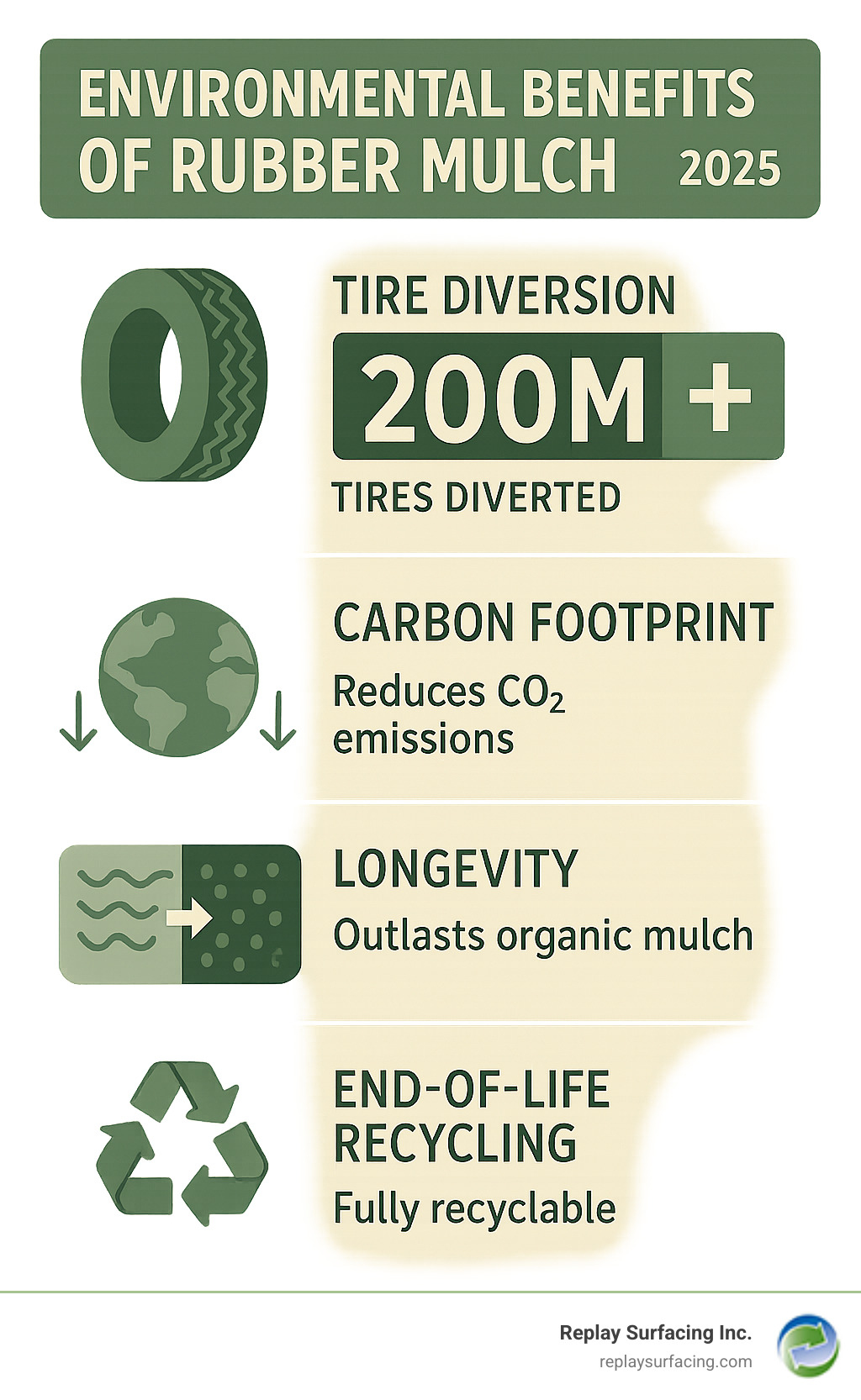
Frequently Asked Questions about Rubber Mulch by the Ton
Let’s tackle the most common questions from facility managers, school administrators, and parents considering rubber mulch per ton purchases.
Is rubber mulch safe for kids and pets?
This is always the first question, and I completely understand why. The safety testing is extensive and reassuring. Rubber mulch per ton products undergo rigorous impact testing, toxicity screening, and specialized pet safety evaluations. We remove 99.9% of steel content during processing.
Independent laboratories test every batch for heavy metals, volatile organic compounds, and other potential contaminants. Results consistently show levels well below strict safety thresholds established by CPSC and ASTM standards.
Veterinary insights are particularly interesting. Vets tell us that if pets accidentally ingest small amounts of rubber mulch, it passes through their digestive systems without causing harm. Obviously, we don’t recommend it as a snack, but accidents happen and parents can rest easy.
The impact testing results really sold me on this material. Rubber mulch absorbs 2.5 times more energy than traditional surfaces like sand, gravel, or wood chips. That’s measurable injury prevention.
How long does the color last on bulk mulch?
Our color-lock process really shines here. We’re not talking about spray paint that chips off after one winter. This is integrated color technology that bonds directly with the rubber material during manufacturing.
Our 12-year guarantee covers normal weather exposure including blazing summer sun, driving rain, snow, and crazy temperature swings. The UV inhibitors and penetrating dyes maintain their vibrancy through all of it.
Want to maximize color life? Remove debris regularly with leaf blowers, avoid harsh chemical cleaners, address oil spills promptly, and consider periodic gentle washing for high-traffic areas.
Even when color fading eventually begins after many years, the safety and functional properties remain completely intact.
Where can I buy rubber mulch per ton with fast shipping?
Our regional warehouse locations include Charlotte NC, Columbia SC, Raleigh NC, Sanford NC, Tucson AZ, Connecticut, Indiana, Nashville TN, Beaverton OR, and Lake Charles Louisiana. These strategically placed hubs typically offer 1-2 week delivery times.
Online ordering works well for most customers, especially those ordering under 4,000 pounds. Will-call pickup is often the fastest option if you’re near one of our warehouses.
Delivery timelines vary by season. Spring rush season (March through May) stretches delivery times to 2-4 weeks. Summer and fall orders typically ship within 1-2 weeks. Custom colors add 1-2 weeks to any order.
Conclusion
When you step back and look at the complete picture, rubber mulch per ton purchasing makes perfect sense for anyone serious about playground safety and smart budgeting. At $529-$789 per ton with coverage of 260-300 square feet at 3-inch depth, you’re not just buying mulch – you’re investing in decades of protection and peace of mind.
Here at Replay Surfacing, we’ve seen how changing waste tires into durable play surfaces changes everything. Every single ton we produce keeps 50,000 tires out of landfills while creating safer spaces for children to play and grow.
The math really is compelling when you run the numbers. 2.5 times better safety performance than wood mulch, 12-year color warranties that actually mean something, ADA compliance for inclusive play, and 65% cost savings over five years compared to the endless cycle of replacing organic mulch.
Beyond the numbers, there’s something deeply satisfying about making one smart decision that solves multiple problems at once. You eliminate annual mulch replacement headaches, create safer play environments, support environmental sustainability, and save money in the long run.
Ready to move forward with your project? We’re here to help you calculate exactly what you need and secure the best bulk pricing available. Our team has guided thousands of facilities through this transition from expensive annual wood mulch purchases to smart one-time investments that protect both budgets and children for years to come.
Don’t let another season pass spending money on mulch that will be gone by next spring. Start your project planning with our comprehensive Installing Rubber Mulch guide, and let’s work together to turn environmental hazards into sustainable solutions that keep your community safe, active, and thriving.

